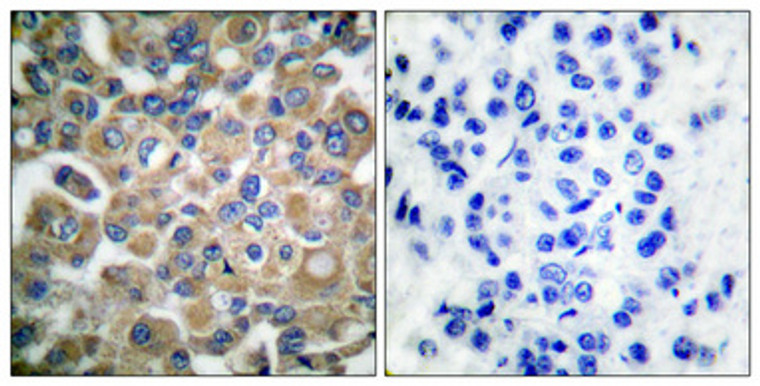| Host: |
Rabbit |
| Applications: |
WB/IHC/IF/ELISA |
| Reactivity: |
Human/Mouse/Rat |
| Note: |
STRICTLY FOR FURTHER SCIENTIFIC RESEARCH USE ONLY (RUO). MUST NOT TO BE USED IN DIAGNOSTIC OR THERAPEUTIC APPLICATIONS. |
| Short Description: |
Rabbit polyclonal antibody anti-Fibrillin-1 (2811-2860 aa) is suitable for use in Western Blot, Immunohistochemistry, Immunofluorescence and ELISA research applications. |
| Clonality: |
Polyclonal |
| Conjugation: |
Unconjugated |
| Isotype: |
IgG |
| Formulation: |
Liquid in PBS containing 50% Glycerol, 0.5% BSA and 0.02% Sodium Azide. |
| Purification: |
The antibody was affinity-purified from rabbit antiserum by affinity-chromatography using epitope-specific immunogen. |
| Concentration: |
1 mg/mL |
| Dilution Range: |
WB 1:500-1:2000IHC 1:100-1:300ELISA 1:20000IF 1:50-200 |
| Storage Instruction: |
Store at-20°C for up to 1 year from the date of receipt, and avoid repeat freeze-thaw cycles. |
| Gene Symbol: |
FBN1 |
| Gene ID: |
2200 |
| Uniprot ID: |
FBN1_HUMAN |
| Immunogen Region: |
2811-2860 aa |
| Specificity: |
FBN1 Polyclonal Antibody detects endogenous levels of FBN1 protein. |
| Immunogen: |
The antiserum was produced against synthesized peptide derived from the human Fibrillin-1 at the amino acid range 2811-2860 |
| Function | Fibrillin-1: Structural component of the 10-12 nm diameter microfibrils of the extracellular matrix, which conveys both structural and regulatory properties to load-bearing connective tissues. Fibrillin-1-containing microfibrils provide long-term force bearing structural support. In tissues such as the lung, blood vessels and skin, microfibrils form the periphery of the elastic fiber, acting as a scaffold for the deposition of elastin. In addition, microfibrils can occur as elastin-independent networks in tissues such as the ciliary zonule, tendon, cornea and glomerulus where they provide tensile strength and have anchoring roles. Fibrillin-1 also plays a key role in tissue homeostasis through specific interactions with growth factors, such as the bone morphogenetic proteins (BMPs), growth and differentiation factors (GDFs) and latent transforming growth factor-beta-binding proteins (LTBPs), cell-surface integrins and other extracellular matrix protein and proteoglycan components. Regulates osteoblast maturation by controlling TGF-beta bioavailability and calibrating TGF-beta and BMP levels, respectively. Negatively regulates osteoclastogenesis by binding and sequestering an osteoclast differentiation and activation factor TNFSF11. This leads to disruption of TNFSF11-induced Ca(2+) signaling and impairment of TNFSF11-mediated nuclear translocation and activation of transcription factor NFATC1 which regulates genes important for osteoclast differentiation and function. Mediates cell adhesion via its binding to cell surface receptors integrins ITGAV:ITGB3 and ITGA5:ITGB1. Binds heparin and this interaction has an important role in the assembly of microfibrils. Asprosin: Adipokine secreted by white adipose tissue that plays an important regulatory role in the glucose metabolism of liver, muscle and pancreas. Hormone that targets the liver in response to fasting to increase plasma glucose levels. Binds the olfactory receptor OR4M1 at the surface of hepatocytes and promotes hepatocyte glucose release by activating the protein kinase A activity in the liver, resulting in rapid glucose release into the circulation. May act as a regulator of adaptive thermogenesis by inhibiting browning and energy consumption, while increasing lipid deposition in white adipose tissue. Also acts as an orexigenic hormone that increases appetite: crosses the blood brain barrier and exerts effects on the hypothalamus. In the arcuate nucleus of the hypothalamus, asprosin directly activates orexigenic AgRP neurons and indirectly inhibits anorexigenic POMC neurons, resulting in appetite stimulation. Activates orexigenic AgRP neurons via binding to the olfactory receptor OR4M1. May also play a role in sperm motility in testis via interaction with OR4M1 receptor. |
| Protein Name | Fibrillin-1 Cleaved Into - Asprosin |
| Database Links | Reactome: R-HSA-1474228Reactome: R-HSA-1566948Reactome: R-HSA-2129379Reactome: R-HSA-216083Reactome: R-HSA-2173789Reactome: R-HSA-381426Reactome: R-HSA-8957275 |
| Cellular Localisation | SecretedFibrillin-1 And Asprosin Chains Are Still Linked Together During The Secretion From CellsBut Are Subsequently Separated By FurinFibrillin-1: SecretedExtracellular SpaceExtracellular MatrixAsprosin: SecretedSecreted By White Adipose Tissue And Circulates In The Plasma |
| Alternative Antibody Names | Anti-Fibrillin-1 Cleaved Into - Asprosin antibodyAnti-FBN1 antibodyAnti-FBN antibody |
Information sourced from Uniprot.org
12 months for antibodies. 6 months for ELISA Kits. Please see website T&Cs for further guidance








![Anti-Papillomavirus type 1 E2-protein antibody (250-280 aa) [1E4] (STJA0002811) Anti-Papillomavirus type 1 E2-protein antibody (250-280 aa) [1E4] (STJA0002811)](https://cdn11.bigcommerce.com/s-zso2xnchw9/images/stencil/300x300/products/150077/299785/STJA0002811_1__41639.1633363890.jpg?c=1)
